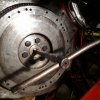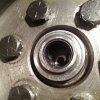On the way down to Goodwood, there was a squealing noise when the engine was started from cold, and I put it down to water pump belt slip. I thought I would deal with it later. Once warm no noise. I drove the car hard on track and it was faultless and didn't change the symptom. Topped up with fuel and set off for the Midlands, parked at Warwick services for a break. Started the car and moved out of the car park to the fuel station and saw significant smoke from the clutch area. I had some initial difficulty selecting gear, and severe squealing noise when depressing clutch. Went onto motorway and kept in 5th gear, squealing noise there 90% of the time. I got to my half way point by changing gear without clutch, hoping not to stress things, but I had to stop at a couple of traffic lights, and the clutch felt normal without any additional noise but noise is continuous.
What do you guys think this is?
What do you guys think this is?
Last edited:








